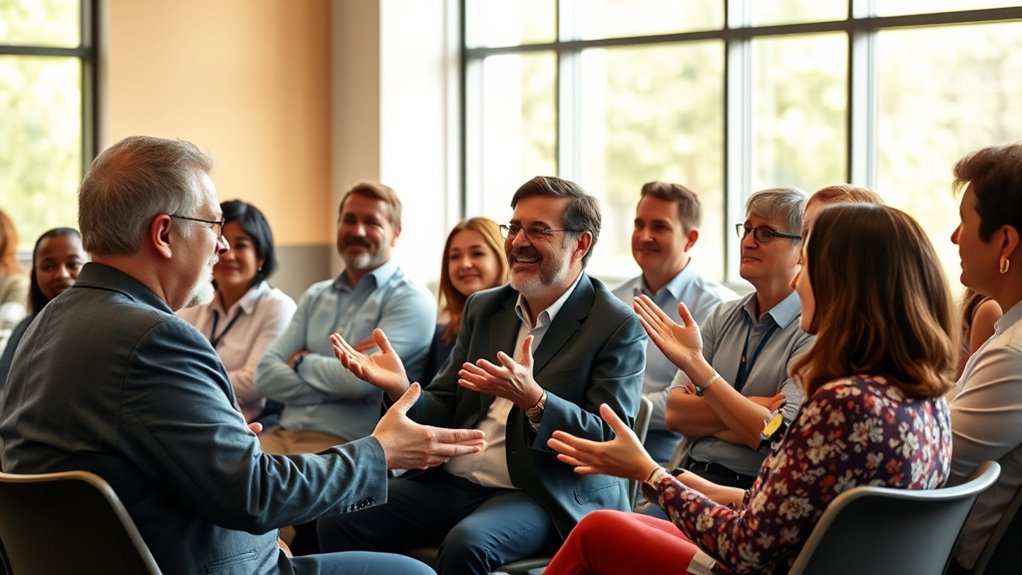To instantly build trust as a facilitator, focus on demonstrating genuine authenticity by maintaining open body language and sharing honest reactions. Practice active listening by giving full attention, nodding, and avoiding interruptions. Set clear expectations and boundaries to create a safe space, and always acknowledge and validate contributors to foster rapport. Finally, model respectful and inclusive behavior to guarantee everyone feels valued. Keep exploring these habits, and you’ll discover more ways to strengthen trust everywhere you lead.
Key Takeaways
- Demonstrate genuine authenticity through honest body language and transparent communication.
- Practice active listening by giving full attention and validating contributions.
- Set clear expectations and boundaries to foster security and mutual understanding.
- Acknowledge and appreciate participants’ input to build rapport and trust.
- Model respectful, inclusive behavior to create a safe environment for open dialogue.
Demonstrate Genuine Authenticity

To build trust as a facilitator, demonstrating genuine authenticity is essential. Your body language plays a crucial role in conveying honesty and openness. Maintain eye contact, use open gestures, and avoid crossing your arms, which can seem defensive. Show emotional transparency by sharing your genuine reactions and thoughts, making participants feel comfortable being authentic themselves. When you’re transparent about your feelings or uncertainties, it encourages others to do the same. Authenticity isn’t about perfection; it’s about being real and consistent. Your body language and emotional openness work together to create a safe environment where trust can flourish. By embodying these qualities, you demonstrate that your intentions are sincere, making others more likely to engage honestly and openly. Incorporating sound healing principles into your approach can also subtly enhance the atmosphere of trust and healing.
Practice Active Listening Attentively

Practicing active listening attentively is essential for building trust as a facilitator because it shows participants that you genuinely value their contributions. When you listen with full attention, you demonstrate empathy building, making others feel heard and respected. Pay close attention to nonverbal cues like eye contact, nodding, and facial expressions, which reinforce your engagement and understanding. Avoid interrupting and focus on truly understanding their perspective before responding. Your body language should convey openness and attentiveness, helping participants feel safe sharing their ideas. By practicing this habit consistently, you foster a trusting environment where everyone feels valued, encouraging honest dialogue and collaboration. Active listening isn’t just about hearing; it’s about connecting and reflecting empathy through your words and nonverbal signals. Additionally, understanding the impact of Natural Language Processing (NLP) can help facilitators better interpret and respond to participants’ needs, enhancing the effectiveness of communication.
Set Clear Expectations and Boundaries

Establishing clear expectations and boundaries from the outset helps create a safe and productive environment for everyone involved. Start by setting ground rules that outline acceptable behavior and participation. This helps prevent misunderstandings and ensures everyone feels respected. Clear role clarification is essential—make sure each person understands their responsibilities and contributions. When roles are defined, team members are more likely to stay focused and engaged. Communicate these expectations openly and encourage questions to confirm understanding. By doing so, you build trust, as people know what to expect and feel secure in the process. Setting these boundaries early lays a strong foundation for collaboration and minimizes conflicts, making your facilitation more effective and trustworthy. Additionally, understanding the importance of anime culture can help facilitators connect more deeply with diverse audiences.
Acknowledge and Validate Contributions

How often do you recognize the efforts of your team members during a facilitation? Acknowledging and validating contributions is key to building rapport and fostering trust. When you genuinely appreciate someone’s input, you show emotional validation, making them feel seen and valued. This encourages openness and participation, helping the group work more cohesively. Instead of brushing off ideas, thank contributors specifically for their insights, even if you disagree. This not only affirms their effort but also demonstrates respect. Remember, consistent acknowledgment signals that you’re listening and that everyone’s voice matters. As a result, trust deepens, and team members feel more comfortable sharing their thoughts openly, knowing their contributions are truly valued in the process. Additionally, understanding risk management strategies can help you navigate uncertainties and build confidence in your facilitation approach.
Model Respectful and Inclusive Behavior

Model respectful and inclusive behavior by consistently demonstrating consideration for all participants’ perspectives and backgrounds. Show cultural awareness by recognizing and valuing diverse experiences, which fosters trust and openness. Practice language sensitivity by choosing words carefully, avoiding assumptions or stereotypes that may alienate others. When someone shares a different viewpoint, listen attentively and respond respectfully, reinforcing an environment of mutual respect. Remember, inclusive behavior isn’t just about words; it’s also about actions—being mindful of body language and tone. By modeling these habits, you create a safe space where everyone feels valued and heard. This approach not only builds trust but also encourages honest dialogue, making your facilitation more effective and engaging for all participants.
Frequently Asked Questions
How Can I Rebuild Trust After a Mistake During Facilitation?
When you make a mistake during facilitation, focus on rebuilding trust by openly acknowledging the error. You build credibility by taking responsibility and explaining how you’ll manage expectations moving forward. Show genuine humility, apologize sincerely, and share your plan to correct the situation. This transparency reassures participants, demonstrates your commitment, and fosters trust, making it easier to move past the mistake and continue productive facilitation.
What Are Subtle Signs That Participants Distrust the Process?
You might not realize it, but subtle signs of distrust are everywhere—like non-verbal cues or facial expressions that scream “I don’t believe you.” When participants avoid eye contact, cross their arms, or show skepticism through their expressions, it’s a clear sign they’re questioning the process. These tiny signals often go unnoticed, but they reveal deep-seated doubts. Recognizing these signs helps you adjust and re-engage their trust effectively.
How Do I Handle Resistance From Participants Effectively?
When handling resistance from participants, you should practice active listening to understand their concerns deeply. Watch their body language for signs of discomfort or disagreement. Respond calmly, acknowledge their perspectives, and ask open-ended questions to encourage dialogue. Your attentive presence and positive body language help defuse tension, making participants feel heard and respected. This approach builds rapport and gradually eases resistance, fostering a more collaborative and trusting environment.
What Strategies Improve Rapport With Diverse Team Members?
To improve rapport with diverse team members, focus on cultural awareness and active listening. Show genuine interest in their perspectives, respecting different backgrounds and experiences. Use open-ended questions and attentive body language to foster trust. By demonstrating understanding and valuing their input, you create a safe environment where everyone feels heard and respected, strengthening your relationships and enhancing collaboration across cultural boundaries.
How Can I Maintain Neutrality in Emotionally Charged Discussions?
Imagine you’re a calm lighthouse amid a stormy sea; maintaining neutrality in emotionally charged discussions is like guiding others safely through turbulent waters. You do this by practicing emotional awareness, recognizing your own reactions, and staying centered. Active listening becomes your anchor, allowing others to feel heard without judgment. Keep your tone steady and focus on facts rather than emotions, helping everyone navigate the conversation with clarity and respect.
Conclusion
Trust isn’t built overnight, yet these habits can transform your facilitation instantly. While demonstrating authenticity and practicing active listening seem simple, they create a powerful foundation. On the other hand, neglecting boundaries or dismissing contributions quickly erodes trust. By modeling respect and inclusivity, you set a tone that invites openness. Remember, it’s the small, consistent actions—like genuine listening and clear boundaries—that make the biggest difference in fostering trust and connection.









